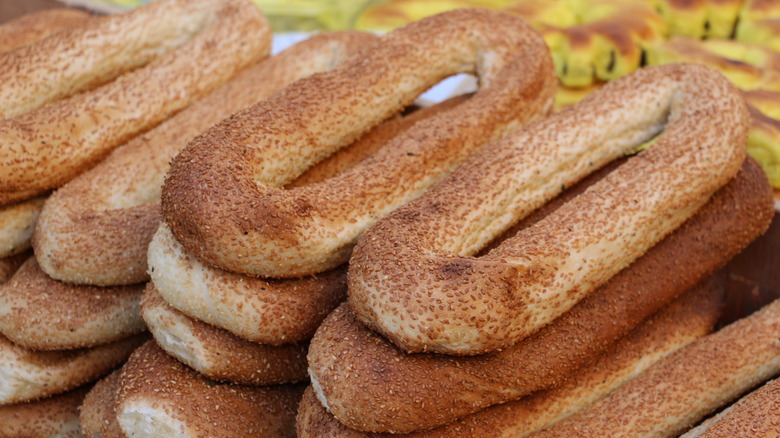The Historic Reason Bagels Have A Hole In The Center
As perfect as a fresh, warm bagel is, you might wonder why it has that hole in the center. Wouldn't bagels be simpler to make if they didn't have a hole? Is the hole just a ploy to cheat us out of that center-most bite? The answer to both questions is no. The signature shape of these tasty baked goods had an important historical function, and today, this iconic feature still serves a vital culinary purpose.
Historically, holes were formed in the middle of bagels so they could be stacked on dowels or threaded on ropes for display. This made bagels easier to transport from one town to the next back in the 14th century, when German bagel vendors were known sell their stock from simple carts and wagons during their migration into Poland. After all, this was far before the time of heated display cases and food trucks.
In modern times, we typically buy bagels in bags, but that iconic center hole remains — not just because it's traditional, but because the puncture helps the dough cook all the way through. These baked treats are pretty dense, and lumps of bagel dough could wind up with an stubbornly undercooked center, if not for the hole that allows heat to seep into the middle. What's more, the hole increases the bagel's surface area, creating more of that crisp crust that's a hallmark of an amazing chewy bagel recipe.
The possible origin of bagel holes includes many other theories
Although ease of transport is the most widely-accepted explanation for bagel holes, historians have voiced other theories. Some say the bagel was created in 1683 in honor of German king Jan Sobieski, and was meant to resemble a stirrup. The king had a great love for his warhorse, and after he led his people to victory in battle, a Polish baker invented the bagel. Interestingly, the German word for stirrup is "beugel," and the bread is often said to be descended from German rolls known as obwarzanek.
Ring-shaped bagels may have also risen up in medieval Europe due to their connotation of good luck, making them a popular gift for pregnant women. Since a circle has no end, these baked goods represented a long life and protection against the "evil eye," helping with safe childbirth. Jewish citizens of 17th century Poland also believed the lucky bagel represented the circle of life and the turnover of one year to the next, similar to the round challah loaves served during Rosh Hashanah.
Others suggest that bagels came about in 13th century Poland.The country's Jewish population was once forbidden to bake bread, as bread was a symbol of Christ's body and Jews were viewed as enemies of the Christian church. When this restriction was lifted, Jews were finally allowed to work with bread, so long as it was cooked via boiling. Rings of dough were easier to boil evenly, compared to solid lumps.
Modern bagels come in various shapes
Just as the cultural meaning and basic recipe of the bagel has evolved over the years, so has the shape. Many fans would say that the traditional smooth, round shape is the best, but some bakers give their versions a braided, rope-like appearance, or even a coiled shape, such as in this ringlet-shaped bagel recipe. Eastern European bagel-like sweets known as sushki look more like a horseshoe than a ring.
On the note of regional bagel varients, Poland has the bialy, which is essentially a flatter bagel with some kind of filling baked into the top. Onions and poppy seeds are a popular bialy filling in both Poland and other countries like the United States. Israel is famous for its Jerusalem-style bagels, which are oval-shaped and baked instead of boiled. Russian bagels, known as bubliki, have much larger holes than other types, and may be coated with cumin seeds.
No matter which way you slice it, bagels have made themselves a beloved culinary fixture all around the globe. Sure, some versions may no longer include a hole in the center, but we all know it's the hole that differentiates most bagels from any old lump of bread.



